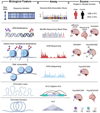Parsing the Functional Impact of Noncoding Genetic Variants in the Brain Epigenome
- PMID: 33131715
- PMCID: PMC7718420
- DOI: 10.1016/j.biopsych.2020.06.033
Parsing the Functional Impact of Noncoding Genetic Variants in the Brain Epigenome
Abstract
The heritability of common psychiatric disorders has motivated global efforts to identify risk-associated genetic variants and elucidate molecular pathways connecting DNA sequence to disease-associated brain dysfunction. The overrepresentation of risk variants among gene regulatory loci instead of protein-coding loci, however, poses a unique challenge in discerning which among the many thousands of variants identified contribute functionally to disease etiology. Defined broadly, psychiatric epigenomics seeks to understand the effects of disease-associated genetic variation on functional readouts of chromatin in an effort to prioritize variants in terms of their impact on gene expression in the brain. Here, we provide an overview of epigenomic mapping in the human brain and highlight findings of particular relevance to psychiatric genetics. Computational methods, including convolutional neuronal networks, and other machine learning approaches hold great promise for elucidating the functional impact of both common and rare genetic variants, thereby refining the epigenomic architecture of psychiatric disorders and enabling integrative analyses of regulatory noncoding variants in the context of large population-level genome and phenome databases.
Keywords: Artificial intelligence; Chromatin; Convolutional neuronal networks; Epigenome; Prefrontal cortex; PsychENCODE.
Copyright © 2020 Society of Biological Psychiatry. Published by Elsevier Inc. All rights reserved.
Conflict of interest statement
Conflicts
The authors report no biomedical financial interests or potential conflicts of interest.
Figures


Similar articles
-
Predicting regulatory variants using a dense epigenomic mapped CNN model elucidated the molecular basis of trait-tissue associations.Nucleic Acids Res. 2021 Jan 11;49(1):53-66. doi: 10.1093/nar/gkaa1137. Nucleic Acids Res. 2021. PMID: 33300042 Free PMC article.
-
Chromatin Profiling Techniques: Exploring the Chromatin Environment and Its Contributions to Complex Traits.Int J Mol Sci. 2021 Jul 16;22(14):7612. doi: 10.3390/ijms22147612. Int J Mol Sci. 2021. PMID: 34299232 Free PMC article. Review.
-
Epigenomic mapping and effect sizes of noncoding variants associated with psychotropic drug response.Pharmacogenomics. 2015;16(14):1565-83. doi: 10.2217/pgs.15.105. Epub 2015 Sep 4. Pharmacogenomics. 2015. PMID: 26340055
-
Epigenomic dissection of Alzheimer's disease pinpoints causal variants and reveals epigenome erosion.Cell. 2023 Sep 28;186(20):4422-4437.e21. doi: 10.1016/j.cell.2023.08.040. Cell. 2023. PMID: 37774680 Free PMC article.
-
Epigenomics in stress tolerance of plants under the climate change.Mol Biol Rep. 2023 Jul;50(7):6201-6216. doi: 10.1007/s11033-023-08539-6. Epub 2023 Jun 9. Mol Biol Rep. 2023. PMID: 37294468 Review.
Cited by
-
Methodological quality assessment of genetic studies on brain arteriovenous malformation related hemorrhage: A cross-sectional study.Front Genet. 2023 Mar 23;14:1123898. doi: 10.3389/fgene.2023.1123898. eCollection 2023. Front Genet. 2023. PMID: 37065486 Free PMC article.
-
Novel Functional Genomics Approaches Bridging Neuroscience and Psychiatry.Biol Psychiatry Glob Open Sci. 2022 Aug 7;3(3):351-361. doi: 10.1016/j.bpsgos.2022.07.005. eCollection 2023 Jul. Biol Psychiatry Glob Open Sci. 2022. PMID: 37519472 Free PMC article. Review.
-
Annotating functional effects of non-coding variants in neuropsychiatric cell types by deep transfer learning.PLoS Comput Biol. 2022 May 16;18(5):e1010011. doi: 10.1371/journal.pcbi.1010011. eCollection 2022 May. PLoS Comput Biol. 2022. PMID: 35576194 Free PMC article.
-
Current and Future Perspectives of Noncoding RNAs in Brain Function and Neuropsychiatric Disease.Biol Psychiatry. 2022 Jan 15;91(2):183-193. doi: 10.1016/j.biopsych.2021.08.013. Epub 2021 Aug 24. Biol Psychiatry. 2022. PMID: 34742545 Free PMC article. Review.
-
Regulatory landscape enrichment analysis (RLEA): a computational toolkit for non-coding variant enrichment and cell type prioritization.BMC Bioinformatics. 2024 May 7;25(1):179. doi: 10.1186/s12859-024-05794-7. BMC Bioinformatics. 2024. PMID: 38714913 Free PMC article.
References
-
- Azevedo FA, Carvalho LR, Grinberg LT, Farfel JM, Ferretti RE, Leite RE, et al. (2009):Equal numbers of neuronal and nonneuronal cells make the human brain an isometrically scaled-up primate brain. J Comp Neurol. 513:532–541. - PubMed
Publication types
MeSH terms
Grants and funding
LinkOut - more resources
Full Text Sources
Other Literature Sources

